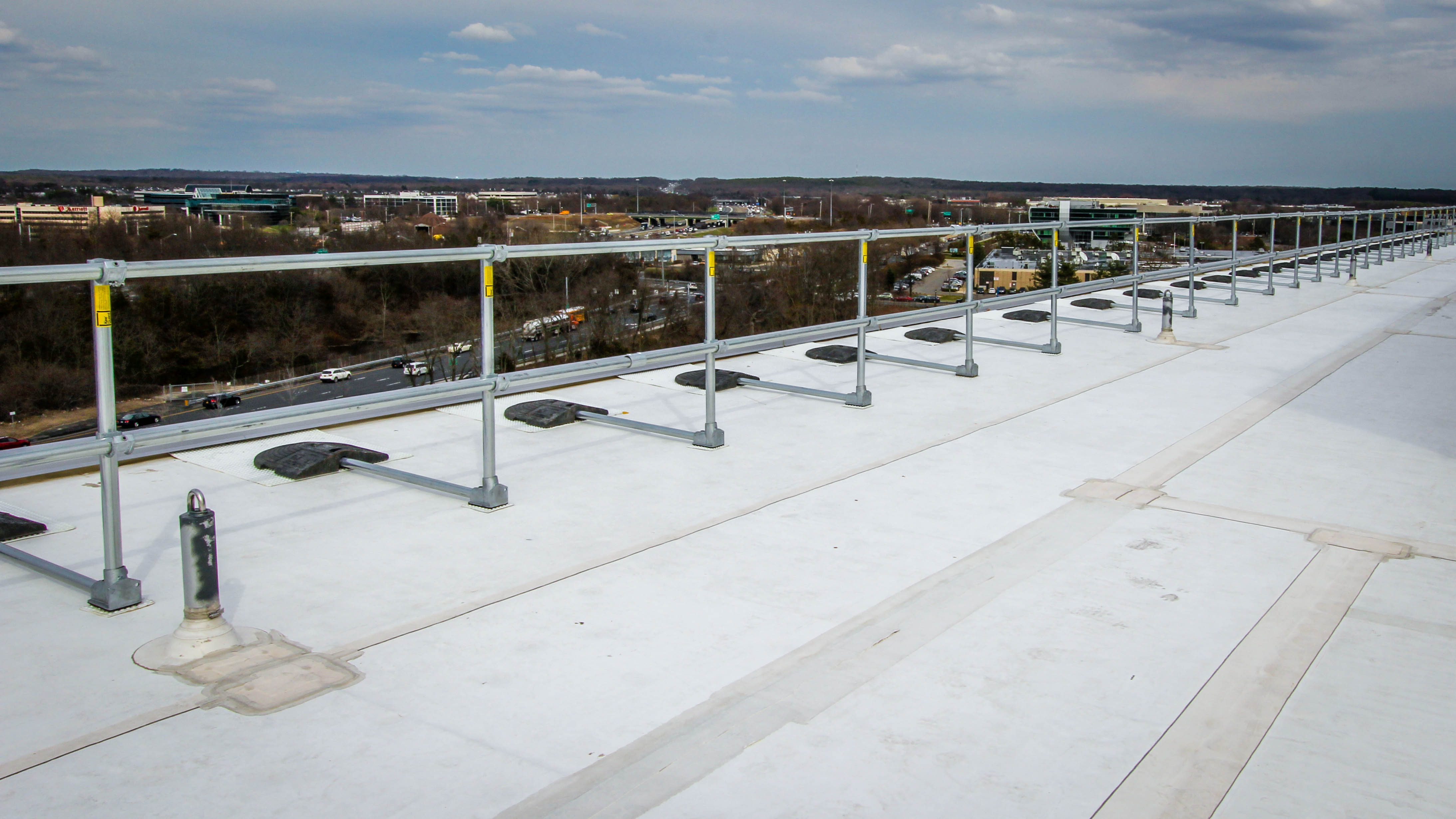How To Install Rooftop Guardrail Safely

Great news – you get to install a roof guardrail system to keep people safe. This guardrail should perform for many years, especially if a highly durable and maintenance free system like KeeGuard safety railing has been selected.
However, how do you keep your crew safe during the installation?
Working with metal and power tools often puts our hands and feet at risk. A way to minimize these risks is to wear appropriate PPE. Heavy-duty work gloves and steel toe boots will protect us from cuts and abrasions, and a proper non-slip sole will offer better traction.
What about the potential fall that this new guardrail system is designed to prevent?
You may not have needed fall protection during the design phase - according to 1910.28(a)(2)(ii) fall protection is required unless "employers are inspecting, investigating, or assessing workplace conditions."
Note that installation is not exempted here, so we must comply by following their regulation.
So what do we do?
According to 1926.501(b)(2)(ii):
"Each employee on a walking/working surface 6 feet (1.8 m) or more above a lower level where leading edges are under construction, but who is not engaged in the leading edge work, shall be protected from falling by a guardrail system, safety net system, or personal fall arrest system."
Using the hierarchy of controls, let’s explore our options.
Elimination or Substitution
We are heading up to install guardrail, so we certainly can’t eliminate the hazard altogether.
Engineering Controls
An engineering control, like a guardrail, to protect us while installing a guardrail doesn’t make much sense.
Administrative Controls
Is it possible to use administrative controls to limit access to the fall? Not in most cases – we’ll need to work close to the edge for the guardrail we’re installing to do its job. Let’s look at the final control.
Personal Protective Equipment
That leaves us with PPE or Personal Protective Equipment. This requires a proper analysis of the work area and documented a safety plan, along with equipment and training to get the job done.
Ideally, we can work in fall restraint and limit our ability even to reach the fall hazard, but we may need to resort to a fall arrest plan and limit the impact if a fall were to occur. This will be our last resort, however, as it carries significantly more risk.
You will need fall protection equipment to properly outfit your crew, including safety lanyards, full body harnesses, and some kind of roof anchor point. A climbing helmet should be included as your last line of defense – if everything else fails, you may save your life by using a properly fitted helmet with straps.
You can select from a wide variety of lanyards and harnesses and should make OSHA compliance the highest priority, followed by comfort.
The anchorage can be tricky, especially on a building rooftop. Here are a few options depending on your rooftop:
OSHA compliant Cross Arm Straps will often work well if a sufficient structural component is available that can handle 5,000 lbs.
A parapet clamp like the Guardian Parapet Anchor System may work if a structural parapet is available.
Permanent anchor points like Weightanka will be useful when sufficient structural components aren’t available.
It is important to note that single point anchors may limit your work area, so consider a temporary horizontal lifeline to improve productivity.
PPE will only help so long as your crew is trained and supervised. Wearing a harness with an improper connection to the anchorage (or just a dangling lanyard) won’t help at all.
These products are safety-critical and must only be used by a competently trained individual, so be sure to read and share the instructions for use entirely before use.
It can be easy to overlook nearby hazards that may not be part of the original installation plan, like skylights. According to 1926.501(b)(4)(i):
"Each employee on walking/working surfaces shall be protected from falling through holes (including skylights) more than 6 feet (1.8 m) above lower levels, by personal fall arrest systems, covers, or guardrail systems erected around such holes."
If your installation puts you near an unprotected skylight, be sure to have a safety plan in place specific to that hazard.
So now we have a robust safety plan, proper equipment, and trained, competent people on the team. Let’s begin the installation! First, we need to designate the staging areas for bringing the materials to our working area.
Hoisting activity must be taken into account. Guardrail systems often arrive on pallets and pipe bundles, so bringing the components to your installation area may put your crew at risk for falls or collisions with the staging equipment.
Lifting equipment like a lull or crane must be operated by a competent and trained person, while coordination between the operator and the crew at height is critical to avoid injuries.
Following the manufacturer instructions during installation is imperative. Assumptions will lead to mistakes, which leads to more time in a dangerous area. Make use of the resources you have available and don’t hesitate to push your supplier for support.
Pre-engineered roof railing systems can make installation a more straightforward, safer project for your crew with training, coaching, and review with your friends at Simplified Safety.
Installing guardrail systems may seem simple at first, but doing so safely requires preparation. Get your people trained, using the right equipment, following a proper safety plan with support from your partners. Their lives are on the line.



